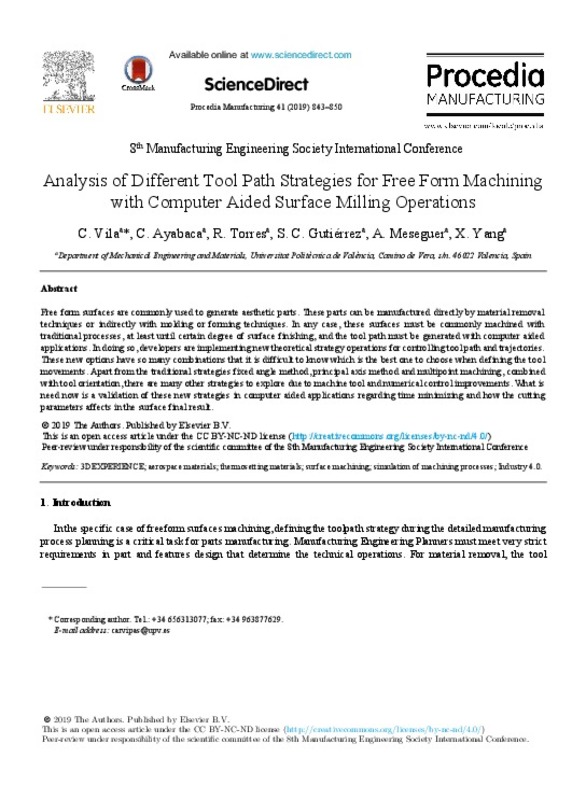JavaScript is disabled for your browser. Some features of this site may not work without it.
Buscar en RiuNet
Listar
Mi cuenta
Estadísticas
Ayuda RiuNet
Admin. UPV
Analysis of Different Tool Path Strategies for Free Form Machining with Computer Aided Surface Milling Operations
Mostrar el registro sencillo del ítem
Ficheros en el ítem
| dc.contributor.author | Vila, C.
|
es_ES |
| dc.contributor.author | Ayabaca-Sarria, Cesar
|
es_ES |
| dc.contributor.author | Torres Carot, Rafael
|
es_ES |
| dc.contributor.author | Gutiérrez, S. C.
|
es_ES |
| dc.contributor.author | Meseguer, Maria-Desamparados
|
es_ES |
| dc.contributor.author | Yang, X.
|
es_ES |
| dc.date.accessioned | 2020-06-10T03:32:41Z | |
| dc.date.available | 2020-06-10T03:32:41Z | |
| dc.date.issued | 2019 | es_ES |
| dc.identifier.uri | http://hdl.handle.net/10251/145867 | |
| dc.description.abstract | [EN] Free form surfaces are commonly used to generate aesthetic parts. These parts can be manufactured directly by material removal techniques or indirectly with molding or forming techniques. In any case, these surfaces must be commonly machined with traditional processes, at least until certain degree of surface finishing, and the tool path must be generated with computer aided applications. In doing so, developers are implementing new theoretical strategy operations for controlling tool path and trajectories. These new options have so many combinations that it is difficult to know which is the best one to choose when defining the tool movements. Apart from the traditional strategies fixed angle method, principal axis method and multipoint machining, combined with tool orientation, there are many other strategies to explore due to machine tool and numerical control improvements. What is need now is a validation of these new strategies in computer aided applications regarding time minimizing and how the cutting parameters affects in the surface final result. | es_ES |
| dc.description.sponsorship | The authors would like to thanks Universitat Politècnica de València, La Fondation Dassault Systèmes, Carolina Foundation and the National Polytechnic School for the support of this article through the 2017 call and project PIS 16-15 - PIS 16-22. | es_ES |
| dc.language | Inglés | es_ES |
| dc.publisher | Elsevier | es_ES |
| dc.relation.ispartof | Procedia Manufacturing | es_ES |
| dc.rights | Reconocimiento - No comercial - Sin obra derivada (by-nc-nd) | es_ES |
| dc.subject | 3D EXPERIENCE | es_ES |
| dc.subject | Aerospace materials | es_ES |
| dc.subject | Thermosetting materials | es_ES |
| dc.subject | Surface machining | es_ES |
| dc.subject | Simulation of machining processes | es_ES |
| dc.subject | Industry 4.0 | es_ES |
| dc.subject.classification | INGENIERIA DE LOS PROCESOS DE FABRICACION | es_ES |
| dc.title | Analysis of Different Tool Path Strategies for Free Form Machining with Computer Aided Surface Milling Operations | es_ES |
| dc.type | Artículo | es_ES |
| dc.type | Comunicación en congreso | es_ES |
| dc.identifier.doi | 10.1016/j.promfg.2019.10.006 | es_ES |
| dc.relation.projectID | info:eu-repo/grantAgreement/EPN//PIS 16-15/ | es_ES |
| dc.relation.projectID | info:eu-repo/grantAgreement/EPN//PIS 16-22/ | es_ES |
| dc.rights.accessRights | Abierto | es_ES |
| dc.contributor.affiliation | Universitat Politècnica de València. Departamento de Ingeniería Mecánica y de Materiales - Departament d'Enginyeria Mecànica i de Materials | es_ES |
| dc.description.bibliographicCitation | Vila, C.; Ayabaca-Sarria, C.; Torres Carot, R.; Gutiérrez, SC.; Meseguer, M.; Yang, X. (2019). Analysis of Different Tool Path Strategies for Free Form Machining with Computer Aided Surface Milling Operations. Procedia Manufacturing. 41:843-850. https://doi.org/10.1016/j.promfg.2019.10.006 | es_ES |
| dc.description.accrualMethod | S | es_ES |
| dc.relation.conferencename | 8th Manufacturing Engineering Society International Conference (MESIC 2019) | es_ES |
| dc.relation.conferencedate | Junio 19-21,2019 | es_ES |
| dc.relation.conferenceplace | Madrid, España | es_ES |
| dc.relation.publisherversion | https://doi.org/10.1016/j.promfg.2019.10.006 | es_ES |
| dc.description.upvformatpinicio | 843 | es_ES |
| dc.description.upvformatpfin | 850 | es_ES |
| dc.type.version | info:eu-repo/semantics/publishedVersion | es_ES |
| dc.description.volume | 41 | es_ES |
| dc.identifier.eissn | 2351-9789 | es_ES |
| dc.relation.pasarela | S\405371 | es_ES |
| dc.contributor.funder | Fundación Carolina | es_ES |
| dc.contributor.funder | Universitat Politècnica de València | es_ES |
| dc.contributor.funder | Escuela Politécnica Nacional, Ecuador | es_ES |
| dc.subject.ods | 09.- Desarrollar infraestructuras resilientes, promover la industrialización inclusiva y sostenible, y fomentar la innovación | es_ES |








